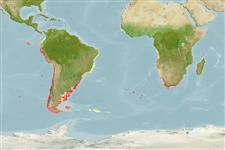Hexacorallia |
Actiniaria |
Sagartiidae
Environment: milieu / climate zone / djupintervall / distribution range
Ekologi
; djupintervall 0 - 60 m (Ref. 87801). Subtropical
Southern Atlantic, Southeast Pacific and Subantarctic. Subtropical to polar.
Length at first maturity / Size / Weight / Age
Könsmognad: Lm ? range ? - ? cm
It expels acontia through its cinclides that can burn sensitive skin (Ref. 87801). It is found on rocky and biogenic substrates, in crevices, or under overhangs particularly in areas with exposed tidepools up to a depth of 60 m (Ref. 87801). Solitary (Ref. 2377). Also found on Macrocystis pyrifera kelp bed and Lessonia trabeculata patches (Ref. 92519).
Life cycle and mating behavior
Könsmognad | Reproduktion | Lek | Eggs | Fecundity | Larvae
Members of the class Anthozoa are either gonochoric or hermaphroditic. Mature gametes are shed into the coelenteron and spawned through the mouth. Life cycle: The zygote develops into a planktonic planula larva. Metamorphosis begins with early morphogenesis of tentacles, septa and pharynx before larval settlement on the aboral end.
Häussermann, V. and G. Försterra 2009 Marine benthic fauna of Chilean Patagonia. Santiago, Nature in Focus. 1000 p. (Ref. 87801)
IUCN Red List Status
(Ref. 130435: Version 2025-1)
CITES status (Ref. 108899)
Not Evaluated
Not Evaluated
Threat to humans
Other
Human uses
| FishSource |
Verktyg
Ytterligare information
Trophic EcologyFood items (preys)
Födosammansättning
Födointag
Predatorer
Population dynamicsTillväxtMax. ages / sizesLength-weight rel.Length-length rel.Length-frequenciesMass conversionAbundans PhysiologySyreförbrukning
Human RelatedStamps, coins, misc.
Internet-källor
Estimates based on models
Preferred temperature
(Ref.
115969): 7.8 - 22.6, mean 14 (based on 228 cells).
Price category
Unknown.
